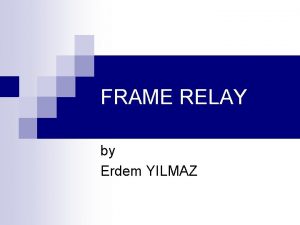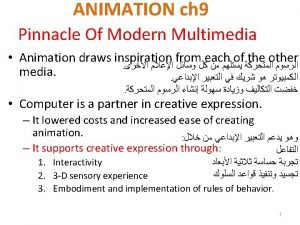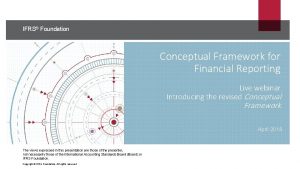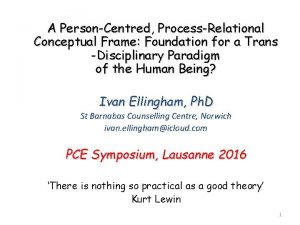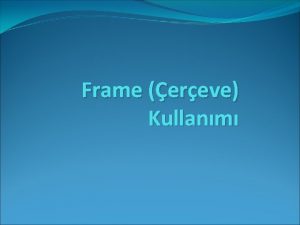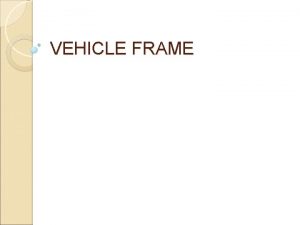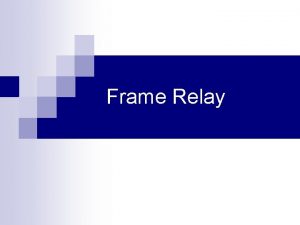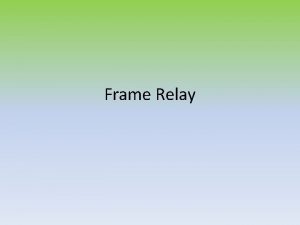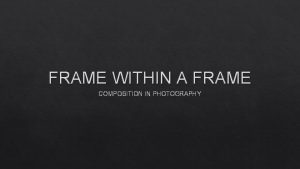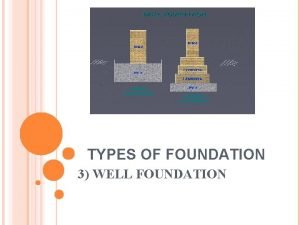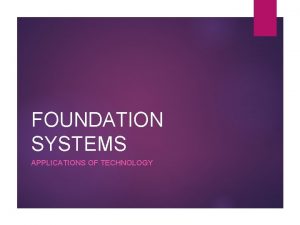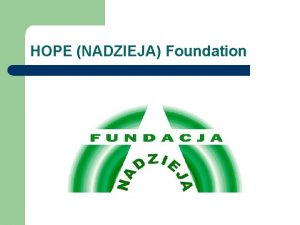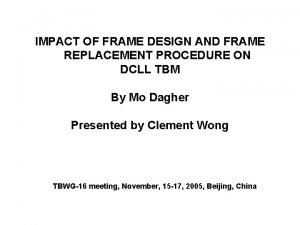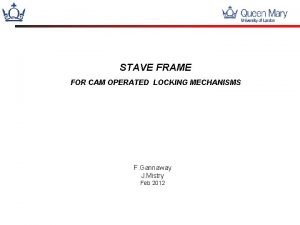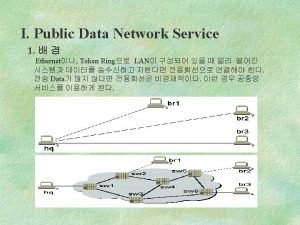A PersonCentred ProcessRelational Conceptual Frame Foundation for a


![Theory A theory is a network of ideas (especially abstract ideas [concepts]) that Theory A theory is a network of ideas (especially abstract ideas [concepts]) that](https://slidetodoc.com/presentation_image_h/758e7e2dfd864cb6a26a8eb6a7fea26d/image-3.jpg)








![The 20 th Century Paradigm Shift Cartesian-Newtonian Process-Relational [Holistic/Organismic /Systemic] ‘The new vision of The 20 th Century Paradigm Shift Cartesian-Newtonian Process-Relational [Holistic/Organismic /Systemic] ‘The new vision of](https://slidetodoc.com/presentation_image_h/758e7e2dfd864cb6a26a8eb6a7fea26d/image-12.jpg)


![Major Importance of Alfred North Whitehead’s Process-Relational/Philosophy of Organism ‘We see [Whitehead’s] Process and Major Importance of Alfred North Whitehead’s Process-Relational/Philosophy of Organism ‘We see [Whitehead’s] Process and](https://slidetodoc.com/presentation_image_h/758e7e2dfd864cb6a26a8eb6a7fea26d/image-15.jpg)




![1. A Fundamental Principle of Creativity Giving Rise to All That Is [Rogers] ‘A 1. A Fundamental Principle of Creativity Giving Rise to All That Is [Rogers] ‘A](https://slidetodoc.com/presentation_image_h/758e7e2dfd864cb6a26a8eb6a7fea26d/image-20.jpg)
![A Fundamental Principle of Creativity Giving Rise to All That Is [Whitehead] ‘The A Fundamental Principle of Creativity Giving Rise to All That Is [Whitehead] ‘The](https://slidetodoc.com/presentation_image_h/758e7e2dfd864cb6a26a8eb6a7fea26d/image-21.jpg)







![Symbol of Form of Events [Abstract Form, Logical Pattern] 29 Symbol of Form of Events [Abstract Form, Logical Pattern] 29](https://slidetodoc.com/presentation_image_h/758e7e2dfd864cb6a26a8eb6a7fea26d/image-29.jpg)


![6. Interconnectedness in terms of Maintenance and Enhancement A [creative] tendency toward fulfillment, toward 6. Interconnectedness in terms of Maintenance and Enhancement A [creative] tendency toward fulfillment, toward](https://slidetodoc.com/presentation_image_h/758e7e2dfd864cb6a26a8eb6a7fea26d/image-32.jpg)
![7. Maintenance ‘Endurance [maintenance] is the repetition of pattern in successive events’. (Whitehead, 1925) 7. Maintenance ‘Endurance [maintenance] is the repetition of pattern in successive events’. (Whitehead, 1925)](https://slidetodoc.com/presentation_image_h/758e7e2dfd864cb6a26a8eb6a7fea26d/image-33.jpg)



![Dialectical Enhancement Through ‘Meeting’ Requires Congruence Between Events ‘Whenever one man’s [sic] hand joins Dialectical Enhancement Through ‘Meeting’ Requires Congruence Between Events ‘Whenever one man’s [sic] hand joins](https://slidetodoc.com/presentation_image_h/758e7e2dfd864cb6a26a8eb6a7fea26d/image-37.jpg)











![The Human Being as The Animal Symbolicum ‘Instead of defining man [sic] as animal The Human Being as The Animal Symbolicum ‘Instead of defining man [sic] as animal](https://slidetodoc.com/presentation_image_h/758e7e2dfd864cb6a26a8eb6a7fea26d/image-49.jpg)










- Slides: 59

A Person-Centred, Process-Relational Conceptual Frame: Foundation for a Trans -Disciplinary Paradigm of the Human Being? Ivan Ellingham, Ph. D St Barnabas Counselling Centre, Norwich ivan. ellingham@icloud. com PCE Symposium, Lausanne 2016 ‘There is nothing so practical as a good theory’ Kurt Lewin 1

Paradigm ≈ Global/Super Theory 2
![Theory A theory is a network of ideas especially abstract ideas concepts that Theory A theory is a network of ideas (especially abstract ideas [concepts]) that](https://slidetodoc.com/presentation_image_h/758e7e2dfd864cb6a26a8eb6a7fea26d/image-3.jpg)
Theory A theory is a network of ideas (especially abstract ideas [concepts]) that identifies a meaningful order/interrelationship between facts/data otherwise likely regarded as unrelated/unconnected 3

HEAVENLY EVENTS Concept of Gravity EARTHLY EVENTS Newton’s theory unified heavenly and earthly events in terms of the concept of gravity. 4

Developing a Paradigm of the Human Being/Person Key Problem Integrating/Unifying The Naturwissenschaftliche Perspective of the Natural Sciences & The Geisteswissenschaftliche Perspective of the Human or Cultural Sciences 5

Connected With Developing a conceptual scheme, a coherent network of concepts, that unifies our current understandings of the workings of the mind and the workings of the body Transcending the ‘Bifurcation’ of the philosophical perspective of Descartes & Newton 6

Unifying Naturwissenschaft & Geisteswissenschaft In the Person-Centred World In ‘The foundations of a person-centered approach’ in A Way of Being (1980), Carl Rogers attempts such unification on the basis of the core concept of the formative (actualizing) tendency. ‘This hypothesis. . . definitely forms a base for the person-centered approach’. (Rogers, 1980) 7

Rogers ‘The foundations for a person-centered approach’ Cultural Science Natural Science Martin Buber Zen Taoism Buddhism Philosophy Ilya Prigogine Albert Szent-Gyoergi Jonas Salk Hans Driesch Theoretical Physicists Chemists Open Systems Theory 8

Geisteswissenschaftliche Perspective (Mental) Concept of Formative Tendency Naturwissenschaftliche Perspective (Material) 9

How to further advance such Geistes-/Naturwissenschaft integration apropos the nature of the human being? Integrate theoretical formulations of Jürgen Kriz and Peter Schmid in a similar fashion to Les Greenberg 10

My Hypothesis & Proposal 11
![The 20 th Century Paradigm Shift CartesianNewtonian ProcessRelational HolisticOrganismic Systemic The new vision of The 20 th Century Paradigm Shift Cartesian-Newtonian Process-Relational [Holistic/Organismic /Systemic] ‘The new vision of](https://slidetodoc.com/presentation_image_h/758e7e2dfd864cb6a26a8eb6a7fea26d/image-12.jpg)
The 20 th Century Paradigm Shift Cartesian-Newtonian Process-Relational [Holistic/Organismic /Systemic] ‘The new vision of reality we have been talking about is based on awareness of the essential interrelatedness and interdependence of all phenomena—physical, biological, psychological, social, and cultural. It transcends current disciplinary and conceptual boundaries and will be pursued within new institutions. At present there is no well-established framework, either conceptual or institutional that would accommodate the formulation of the new paradigm’. (Capra, The Turning Point, 1982) 12

Developing Person-Centred Theory in Process-Relational Terms ‘Person-centred theory is, at its core, organismic’ (i. e. process-relational). If person-centred theory is to become more coherent and comprehensive and an integral part of the emerging paradigm ‘various of theory’s key concepts need to be organismically ‘purified’’. . ‘We should seek to define all personcentred concepts in exclusively organismic [processrelational, systemic] rather than C-N terms’ (Ellingham, 2002) 13

Outside Help from Non-PC Process Relational Thinkers ‘Person-centred theory exhibits crucial flaws. . . to the extent that its base concepts are not congruent representatives of this emerging [process-relational] paradigm but of the Cartesian-Newtonian paradigm that it supersedes. . To remedy such flaws I have proposed a strategy of ‘organismic assimilation’, a strategy involving assimilating into personcentred theory ideas drawn from organismic [processrelational] thinkers outside the person-centred fold: ideas developed by such thinkers as. . . Ernst Cassirer, . . . [Kieran Egan, ] Arthur Koestler, Susanne Langer, . . . Jean Piaget, Michael Polanyi, . . . [Heinz Werner], Alfred North Whitehead’. Ellingham (2002) 14
![Major Importance of Alfred North Whiteheads ProcessRelationalPhilosophy of Organism We see Whiteheads Process and Major Importance of Alfred North Whitehead’s Process-Relational/Philosophy of Organism ‘We see [Whitehead’s] Process and](https://slidetodoc.com/presentation_image_h/758e7e2dfd864cb6a26a8eb6a7fea26d/image-15.jpg)
Major Importance of Alfred North Whitehead’s Process-Relational/Philosophy of Organism ‘We see [Whitehead’s] Process and Reality as the philosophical ground for organismic psychology and for theory and practice of person-centred therapy’. (Tudor & Worrall, 2006) ‘Rogers acknowledges Whitehead’s part in developing the particular understanding of the universe which he brings to the discussion of the foundations of the person-centred approach. . . Whether or not Rogers was conscious of the impact of Whiteheadian philosophy on the development of his own thinking during his Chicago years, there are traces of Whitehead’s process philosophy to be found throughout his work’. (Neville, The Life of Things, 2012) 15

Major Importance of Ernst Cassirer’s Philosophy of Symbolic Forms ‘Cassirer. . sought to accomplish no less than a reconstruction of twentieth century philosophy, reintegrating two hostile directions of scienceoriented philosophy (best represented by the Vienna Circle of logical positivism) and (often antiscientific) Lebensphilosophie [i. e. Analytic & Continental]--which for Cassirer includes the whole lineage of postidealistic philosophy from Kirkegaard to Heidegger’. Krois (1987) Cassirer: Symbolic Forms and History 16

Key Sources: Person-Centred Rogers’ theory statements of 1950 s and later (Core Conditions; Formative [Actualizing] Tendency) Gendlin’s conception of a Bodily Felt Sense (Merleau-Ponty) Greenberg’s Neo-Piagetian Theorizing (Multi-Level) Kriz’s ‘Person-Centred Systems Theory’ (Meaning Levels) Prouty’s ‘Pre-Symbolic Experiencing’ Schmid (et al, Mearns): Existential/Encounter theorizing 17

Key Sources: Process-Relational Whitehead: Conception of Reality in Process-Relational Terms; Consciousness as ‘Felt Process’ Cassirer and Langer: Exposition of the Cultural Evolution of Human Consciousness in terms of Symbolization (Non-Discursive, Mythic Consciousness) Polanyi: Exposition of the Structure of Tacit Knowing Egan: Exposition of Child development (Mythic Understanding) Werner: Work on Symbol Formation, Microgenesis, Psychosis 18

Basic Concepts Of A Person-Centred, Process-Relational Frame 19
![1 A Fundamental Principle of Creativity Giving Rise to All That Is Rogers A 1. A Fundamental Principle of Creativity Giving Rise to All That Is [Rogers] ‘A](https://slidetodoc.com/presentation_image_h/758e7e2dfd864cb6a26a8eb6a7fea26d/image-20.jpg)
1. A Fundamental Principle of Creativity Giving Rise to All That Is [Rogers] ‘A creative, not a disintegrative process is at work’. ‘A potent creative tendency which has formed our universe’. ‘A tendency which permeates all of organic life’. ‘An evolutionary tendency toward greater order, greater complexity, greater interrelatedness’ ‘A holistic force’. ‘A tendency to become all the complexity of which the organism is capable’. ‘The actualizing tendency is operative in the human being. . . part of a strong formative tendency in our universe, which is evident at all 20 levels. (Rogers, 1980)
![A Fundamental Principle of Creativity Giving Rise to All That Is Whitehead The A Fundamental Principle of Creativity Giving Rise to All That Is [Whitehead] ‘The](https://slidetodoc.com/presentation_image_h/758e7e2dfd864cb6a26a8eb6a7fea26d/image-21.jpg)
A Fundamental Principle of Creativity Giving Rise to All That Is [Whitehead] ‘The ultimate metaphysical ground, the creative advance into novelty’. (Whitehead, 1929) ‘There is a rhythm of process whereby creation produces natural pulsation, each pulsation forming a natural unit of historic fact’. (Whitehead, 1938) ‘Creativity expresses the notion that each event is a process issuing in novelty’. (Whitehead, 1933) 21

Creative Principle: Heinz Werner’s ‘Orthogenetic Principle’ ‘The organismic-holistic orientation, in our framework, is closely interwoven with a developmental orientation: development is a constitutive moment of organismic functioning. We assume that organisms are naturally directed towards a series of transformations--reflecting a tendency to move from a state of relative globality and undifferentiatedness towards states of increasing differentiation and hierarchic integration. It is this tendency, formulated as the ‘orthogenetic principle’, which serves for us to characterize development as distinct from other types of change over time. . In terms of the specific, concrete forms and operations, novel functions and structures ‘emerge’. (Werner & Kaplan, 1963) 22

2. All That Is Is Process (Patterned Activity) ‘Nature is clearly process’. (Rogers, 1963) ‘There is a great deal of evidence to indicate that in many aspects of our culture, including science, we are moving toward a process conception of all aspects of living and life’. (Rogers, 1968) ‘You are a process and your feelings are part of that process’. (Gendlin, 1981) ‘The reality is the process’. (Whitehead, 1925) ‘The thought of ourselves as process immersed in process beyond ourselves’. (Whitehead, 1938) ‘There are no things only processes’. (Waddington, 1969) 23

3. Feeling/Consciousness = ‘Felt Process’ ‘The phenomenon usually described as ‘a feeling’ is really that an organism feels something, i. e. , something is felt. What is felt is a process, perhaps a large complex of processes, within the organism. Some vital activities of great complexity and high intensity, usually (perhaps always) involving nervous tissue, are felt; being felt is a phase of the process itself. A phase is a mode of appearance, and not an added factor…. One may say that some activities, especially nervous ones, above a certain (probably fluctuating) limen of intensity, enter into a ‘psychical phase’. This is the phase of being felt. (Langer, 1967) 24

Nature of Felt (Conscious) Events Comparable to: The sound produced by a vibrating guitar string. The glow of coal above a certain temperature. ‘Awareness is like the glow of a coal which comes from its own combustion’. (Perls, Hefferline & Goodman, 1951). 25

Types of Conscious Experiencing = Types of Felt Process ‘The thesis I hope to substantiate here is that the entire psychological field--including human conception, responsible action, rationality, knowledge--is a vast and branching development of feeling’…. Emotion as we know it is not even a primitive form of feeling’. (Langer, 1967) ‘Feeling’ in the ‘broad sense’ is ‘the generic basis of all mental experience—sensation, emotion, imagination, recollection and reasoning, to mention only the main categories’. (Langer, 1962) [Incorporates Gendlin’s Bodily Felt Sense] 26

4. The Event = The Basic Unit of Process ‘The very essence of real actuality—that is, of the completely real—is process. Thus each actual thing is only to be understood in terms of its becoming and perishing. There is no halt in which the actuality is just its static self’. (Whitehead, 1933) ‘We must start with the event as the ultimate unit of natural occurrence…. The event is the unit of things real’. (Whitehead, 1925) ‘Let the working hypothesis be that the ultimate are the events in their process of origination’. (Whitehead, 1929) ‘We shall conceive each primordial element as a vibratory ebb and flow of an underlying energy, or activity’. (Whitehead, 1925) 27

The Event = The Basic Unit of Process ‘We are time-space events’. (Perls, 1947) ‘An ‘instinct cycle’ (Perls, 1969) is a central paradigm in Gestalt theory and practice…. This cycle of Gestalt formation and destruction is variously referred to as the awareness cycle, the instinct cycle, the contactwithdrawal cycle or the cycle of experience’. (Clarkson, 1989) ‘The idea of growth in PCA and, more generally, in humanistic psychology is exactly that ‘Die and Become’ in accordance with the growth of a deciduous tree—letting go all the leaves in autumn in order to let the new green emerge in spring’. (Kriz, 2013) 28
![Symbol of Form of Events Abstract Form Logical Pattern 29 Symbol of Form of Events [Abstract Form, Logical Pattern] 29](https://slidetodoc.com/presentation_image_h/758e7e2dfd864cb6a26a8eb6a7fea26d/image-29.jpg)
Symbol of Form of Events [Abstract Form, Logical Pattern] 29

5. Events Grasp/Grasping Events An event is a unit of grasping, sensing, ‘prehending, of ‘schematic’ activity. Illustrated by the grasping hand. 30

The Reaching/Grasping Hand 31
![6 Interconnectedness in terms of Maintenance and Enhancement A creative tendency toward fulfillment toward 6. Interconnectedness in terms of Maintenance and Enhancement A [creative] tendency toward fulfillment, toward](https://slidetodoc.com/presentation_image_h/758e7e2dfd864cb6a26a8eb6a7fea26d/image-32.jpg)
6. Interconnectedness in terms of Maintenance and Enhancement A [creative] tendency toward fulfillment, toward actualization, involving not only. . . maintenance but also. . . enhancement’. (Rogers, 1980) ‘ 32
![7 Maintenance Endurance maintenance is the repetition of pattern in successive events Whitehead 1925 7. Maintenance ‘Endurance [maintenance] is the repetition of pattern in successive events’. (Whitehead, 1925)](https://slidetodoc.com/presentation_image_h/758e7e2dfd864cb6a26a8eb6a7fea26d/image-33.jpg)
7. Maintenance ‘Endurance [maintenance] is the repetition of pattern in successive events’. (Whitehead, 1925) Same pattern in successive frames of a movie film. Rapidly waving hands. 33

Maintenance-Duration 34

8. Enhancement Events interact Dialectically Enhancement ‘The actualizing process is a dialogical process…Person-centred therapy. . . holds the conviction that actualization is a dialectical process’. (Schmid, 2008) ‘The basic dialectical axiom. In person-centred anthropology, the basic dialectical axiom is the actualizing tendency--as the force in the individual --embedded in the interconnectedness and social nature of the individual’. (Schmid, 2013) 35

The Handshake ‘The Greater Whole’ Whole 36
![Dialectical Enhancement Through Meeting Requires Congruence Between Events Whenever one mans sic hand joins Dialectical Enhancement Through ‘Meeting’ Requires Congruence Between Events ‘Whenever one man’s [sic] hand joins](https://slidetodoc.com/presentation_image_h/758e7e2dfd864cb6a26a8eb6a7fea26d/image-37.jpg)
Dialectical Enhancement Through ‘Meeting’ Requires Congruence Between Events ‘Whenever one man’s [sic] hand joins with another, we feel [God’s] presence dawning’. (Buber, 1919) Buber conceives the ‘I-Thou’ (Ich-Du) relationship as ‘a unity of contraries. . . at the innermost core of dialogue’ (Buber, 1948). ‘To be fully real the I-Thou relation must be mutual’. (Friedman, 2002) 37

Congruence Between Symbol and Object ‘Symbols and object symbolized must have the same logical form/formal likeness’. (Langer, 1953) 38

‘Meeting’ occurs in the ‘Between’ ‘Unlike the subject-object knowledge of the I-It relation, the knowing or the I-Thou relation takes place neither in the ‘subjective’ nor the ‘objective’, the emotional nor the rational, but in the ‘between’—the reciprocal relationship of whole and active beings’. (Friedman, 2002) ‘It is one thing to declare that the between is the locus of meaning and value. . . but quite another to figure out what possibly can be understood by claiming that this obviously ‘empty’ space between us here is the bearer of our meaning, is filled and charged with meaning, is something metaphysically real. . We tend to balk at invoking an image such as magnetic lines of force—invisible, intangible. . . yet as real as any physical force we know. But think of the ‘force field’ two people generate in heated discussion or intimate copresence. (Tallon, 2004) 39

Rogers’ Description ‘But these strange behaviors turn out to be right, in some odd way: it seems that my inner spirit has reached out and touched the inner spirit of the other. Our relationship transcends itself and becomes a part of something larger. Profound growth and healing are present’. (Rogers, 1980) 40

The ‘Between’, The Spark Jumps Across ‘Real myth is the expression. . . of a real meeting of two Realities’. (Buber, 1950) ‘For a person who is under this mythic-religious attitude. . . external reality is not merely viewed and contemplated, but overcomes a man [sic] in sheer immediacy, with emotions of fear and hope, terror or wish fulfilment, then the spark jumps somehow across, the tension finds release, as the subjective excitement become objectified’. (Cassirer, Language and Myth, 1946) 41

9. Reality, Ourselves & the World, is Multi-Level/Hierarchical Involving Increasing Complexity 42

An Even Greater ‘Whole’: The Circle Dance Many Handshakes 43

Multi-Level Dynamic Complexity ‘The growth tendency works by means of a dynamic system process involving the dialectical coordination of many different elements to form inclusive, coherent syntheses of activated elements. . . The person grows toward greater complexity and coherence by constantly assimilating experience and integrating incongruities. . In EFT the self is seen as a dynamic system, a multiprocess, multilevel organisation that emerges from the dialectical interaction of many component elements’. (Greenberg, 2010) 44

Multi-Level Scheme based on Polanyi/Werner Enhancement Maintenance 45

Person-Centred Thinkers with Multi-Level Views ‘As Seeman’s enquiry evolved, he. . . saw ‘organismic integration’ as a whole organism activity of various ‘subsystems’ working in a ‘transactional process that blends. . . biochemical, physiological, perceptual, cognitive, and interpersonal’ in ways that are ‘congruent, harmonious, and adaptive’ (Wolter. Gustafson, 2013). ‘Person-selves typically live and evolve within a complex environment of relationships, in which systems of relation on a variety of levels carry influence to an from the centre of interpersonal life’. (Barrett-Lennard, 2013) ‘People are seen as dynamic self-organizing systems. . constantly synthesizing conscious experience out of many levels of processing, constantly configuring experience and reality into meaningful wholes’. (Greenberg, 2010) 46

Person-Centred Thinkers with Multi-Level Views ‘What are the principles, metaphors and ideas that are useful to refer to in order to understand the multilevel dynamic of meaning structures? (Kriz, 2006) ‘The process levels are not understood as isolated but interactively interwoven. The main levels in PCST [Person-Centered Systems Theory] are not understood as isolated but interactively interwoven’. (Kriz, 2013) 47

10. The Human Being as The Animal Symbolicum ‘The philosophical primacy of the symbol refers to an epistemological shift from experiencing to the symbolizing of experience. This philosophical primacy of the symbol is asserted by Cassirer (1955), who described the human as ‘animal symbolicum’. This philosophical impulse is further expanded by Susanne Langer (1961), who described the human brain as a ‘transformer’. . This philosophical focus allows us to think of humankind as ‘motivated’ to symbolize experience. (Prouty, 2008) 48
![The Human Being as The Animal Symbolicum Instead of defining man sic as animal The Human Being as The Animal Symbolicum ‘Instead of defining man [sic] as animal](https://slidetodoc.com/presentation_image_h/758e7e2dfd864cb6a26a8eb6a7fea26d/image-49.jpg)
The Human Being as The Animal Symbolicum ‘Instead of defining man [sic] as animal rationale, we should define him as an animal symbolicum’. (Cassirer, 1945) ‘The human brain is constantly carrying on a process of symbolic transformation of the experiential data’. (Langer, 1961) 49

11. Levels of Felt Processing/‘Meaning’/Sense-Making ‘In place of the Hegelian hierarchy of categories of thought, the [process-relational] philosophy of organism finds a hierarchy of categories of feeling’. (Whitehead, 1929) ‘Meaning has both a logical and a psychological aspect. Psychologically, any item that is to have meaning must be employed as a sign or a symbol. . Logically, it must be capable of conveying a meaning. (Langer, 1961) 50

Levels of Felt Processing/’Meaning’/Sense-Making ‘In order to unify and more tightly relate Rogers’ approach with a more advanced and elaborated use of modern systems theory, the so-called person-centered systems theory (PCST) has been developed. . Its main advancement is the distinction of different process levels, each characterized by its own dynamics, attractors, forces of stability, and contribution to the overall process of ‘being in the world’ and making meaning. meani (Kriz, 2013) 51

Levels of Felt Processing/’Meaning’/Sense-Making ‘Reichenbach conceived these different levels of semiotic conceptualization [‘different levels of symbolization’] as different levels of abstraction and concreteness. . An even more primitive form of concreteness is called the pre -symbol. (Prouty, 2008) 52

Levels of Human Import/‘Meaning’/Sense-Making Abstract Scientific ------------------------Everyday Discursive/Common Sense ------------------------Mythic/Pre-Symbolic Experiencing ------------------------Somatic (Cassirer, Egan, Ellingham, Langer) 53

The Reaching/Grasping Hand 54

The Handshake ‘The Greater Whole’ Whole 55

An Even Greater ‘Whole’: The Circle Dance Many Handshakes 56

Cartesian-Newtonian 1. Basic elements are bits of unchanging 1. and self-contained ‘substance’/‘stuff’ isolated in the container of empty space where they are pushed and pulled by external forces (the billiard ball universe). 2. Basic metaphor: the machine. Process-Relational [Holistic, Organismic, Systemic] Basic elements are ‘events’, individual patterns of process (patterned activity, pulsations), immersed in a field of such processes as waves in the sea. Such patterns of process are self-propelled along the ‘channels’ provided by other events/processes in the field. Basic metaphor: the living organism 2. 3. Bifurcation of unconscious matter 3. Everything is process which may or may versus conscious mind. Impossible to not be ‘felt’, i. e. give rise to 57 integrate Body & Mind into single system. awareness/consciousness.

The 20 th Century Paradigm Shift Cartesian-Newtonian Newton & God Pre-Existing Being Machine Metaphor Substance [solid stuff] Body/Mind Bifurcation Atoms Space Single Level Process-Relational [holistic, organismic, systemic] Modern Physicists & Darwin Creative Becoming Organism Metaphor Process Felt Process Events Fields Multi-Level 58

The Two Cultures ‘Two polar groups: at one pole we have the literary intellectuals, at the other scientists, and as the most representative, the physical scientists. Between the two a gulf of mutual incomprehension’. C. P. Snow (1959) The Two Cultures and the Scientific Revolution. 59
 Frame relay frame format
Frame relay frame format What is frame relay
What is frame relay Frame by frame animation programs
Frame by frame animation programs Pengertian animasi frame by frame
Pengertian animasi frame by frame Composition of urine slideshare
Composition of urine slideshare Pad foundation
Pad foundation Foundation of conceptual framework
Foundation of conceptual framework Geometri för barn
Geometri för barn Bris för vuxna
Bris för vuxna En lathund för arbete med kontinuitetshantering
En lathund för arbete med kontinuitetshantering Mat för idrottare
Mat för idrottare Etik och ledarskap etisk kod för chefer
Etik och ledarskap etisk kod för chefer Svenskt ramverk för digital samverkan
Svenskt ramverk för digital samverkan Datorkunskap för nybörjare
Datorkunskap för nybörjare Klädsel i rom
Klädsel i rom Rita perspektiv
Rita perspektiv Ministerstyre för och nackdelar
Ministerstyre för och nackdelar Bat mitza
Bat mitza Nationell inriktning för artificiell intelligens
Nationell inriktning för artificiell intelligens Bästa kameran för astrofoto
Bästa kameran för astrofoto Sju principer för tillitsbaserad styrning
Sju principer för tillitsbaserad styrning Nyckelkompetenser för livslångt lärande
Nyckelkompetenser för livslångt lärande Romarriket tidslinje
Romarriket tidslinje Dikt form
Dikt form Handledning reflektionsmodellen
Handledning reflektionsmodellen Matematisk modellering eksempel
Matematisk modellering eksempel Orubbliga rättigheter
Orubbliga rättigheter Verktyg för automatisering av utbetalningar
Verktyg för automatisering av utbetalningar Shaktismen
Shaktismen Bamse för de yngsta
Bamse för de yngsta Personalliggare bygg undantag
Personalliggare bygg undantag Expektans eller exspektans
Expektans eller exspektans Kyssande vind
Kyssande vind Strategi för svensk viltförvaltning
Strategi för svensk viltförvaltning Stig kerman
Stig kerman Verksamhetsanalys exempel
Verksamhetsanalys exempel Tack för att ni har lyssnat
Tack för att ni har lyssnat Treserva lathund
Treserva lathund Returpilarna
Returpilarna Cks
Cks Läkarutlåtande för livränta
Läkarutlåtande för livränta Påbyggnader för flakfordon
Påbyggnader för flakfordon Inköpsprocessen steg för steg
Inköpsprocessen steg för steg A gastrica
A gastrica Egg för emanuel
Egg för emanuel Tack för att ni har lyssnat
Tack för att ni har lyssnat Standardavvikelse
Standardavvikelse Tidböcker
Tidböcker Rutin för avvikelsehantering
Rutin för avvikelsehantering Vanlig celldelning
Vanlig celldelning Kontinuitetshantering
Kontinuitetshantering Myndigheten för delaktighet
Myndigheten för delaktighet Presentera för publik crossboss
Presentera för publik crossboss Kung dog 1611
Kung dog 1611 Tack för att ni lyssnade
Tack för att ni lyssnade Att skriva debattartikel
Att skriva debattartikel Tobinskatten för och nackdelar
Tobinskatten för och nackdelar Referatmarkeringar
Referatmarkeringar Karttecken stig
Karttecken stig Shingelfrisyren
Shingelfrisyren

